|
Common names:
Australia |
English |
New Guinea mudskipper |
Italy |
Italian |
perioftalmo della Nuova Guinea* |
Papua New Guinea |
Purutu language |
sakomo |
* proposed name
|
|
|
Synonyms:
Etymology:
'Periophthalmus' is a compound name from the Greek 'peri' (around), and 'ophthalmôn' (eye), which refers to the wide visual field of these species
the specific name indicates the type locality: New Guinea
|
Maximum recorded length:
53 mm SL (Polgar et al., 2010)
Live colouration
(Larson & Takita, 2004; Jaafar & Larson, 2008; Polgar et al., 2010; Takita et al., 2011):
background colour light brown to greyish on head, dorsum and flankes, ventrally whitish; head with dark brown streaks and mottling on dorsum; 7-8 dorsal dark brown saddle-like diagonal bars on dorsum, usually well evident; blotches between bars may be present; sky blue iridescent speckles, and/or short vertical stripes on sides of head and body; small reddish brown speckles may also be visible on head and flanks. D1 membrane brown, basally paler, and a
transparent margin; a darker submarginal band may be present; D2 transparent with a proximal series of dark brown spots or streaks, an inframarginal dark brown stripe and a transparent margin; caudal fin dusky, with series of dark speckles along rays, proximally darker;
anal fin hyaline, pigmented along rays in some specimens; pelvic fins whitish ventrally, dorsally brownish; pectoral fins hyaline with brownish rays.
Males are darker than females, with more heavily pigmented anal and pelvic fins
Colouration on preservation
(Larson & Takita, 2004; Jaafar & Larson, 2008; pers. obs.: Papua New Guinea):
ground colour dorsally and laterally grey to brown, ventrally paler; dark dorsal banded pattern and blotches usually visible; D1 brown
with a darker submarginal band and a white or transparent margin;
D2 transparent with a proximal series of brown spots or streaks, a brown inframarginal stripe and a transparent margin; caudal fin dusky with series of
dark speckles on rays; pectoral fins dusky; pelvic
and anal fins frequently pigmented between fin rays: pelvic fins darker on the dorsal side.
Males darker than females, with more heavily pigmented anal and pelvic fins
Diagnosis (Larson & Takita, 2004; Jaafar & Larson, 2008):
D1 IX-XIV; total D2 elements 13-14; total anal fin elements 11-12; pectoral fin rays 12-15; longitudinal scale count 71-110; predorsal scales 25-32; pelvic fins united
for more than 3/4 their length, with a distinct frenum, and tips rounded; colouration traits of D1, D2, anal and pelvic fins.
The genus is yet undefined by synapomorphies
Diet:
no published study is available
|
|
Reproduction:
no published study is available
|
|
|
|
|
Ecological notes (Polgar et al., 2010; Takita et al., 2011; pers. obs.: Australia NT):
locally very abundant in the low intertidal zone, along mud banks of tidal creeks, inlets and tide pools, never far from the water's edge, where it feeds.
It can be found in almost pure fresh water in tidally influenced rivers. Nursall
(1981) found P. expeditionum (jun. syn. of P. novaeguineaensis)
also on steep creek mud banks, possibly because of direct competition with
Pn. freycineti; nonetheless, the identification of P. expeditionum sensu Nursall (1981) is probably unreliable (see Remarks)
left: bank of a large river: here P. novaeguineaensis was found on the exposed mud, nearby water (Adelaide river, Northern Territory, Australia)
right: mud banks of a tidal creek. Also here P. novaeguineaensis was always found nearby the water edge (Purutu Is., Fly river delta, Papua New Guinea)
(photos, left: G. Polgar, 2007; right: A. Sacchetti, 2007, with permission)
|
|
|
|
|
Distribution (Larson & Takita, 2004; Jaafar & Larson, 2008; Polgar et al., 2010):
recorded from northern Australia; New Guinea (Indonesia); and Fly river delta, Papua New Guinea (Polgar et al., 2010);
type locality: Merauke, New Guinea
|
|
|
Remarks:
this species was described as P. murdyi by Larson & Takita
(2004), who found several specimens in the lots identified by Murdy (1989) as P. novaeguineaensis Eggert; nonetheless, they did not examine the lectotype of P. novaeguineaensis.
When Jaafar & Larson (2008) examined the lectotype, they realised that it was identical to P. murdyi; therefore, the latter taxon became a junior synonym of P. novaeguineaensis Eggert, and the species that Larson & Takita (2004) had re-diagnosed as P. novaeguineaensis, was described as P. takita n.sp.; they also found that 3 paralectotypes of P. novaeguineaensis Eggert are P. darwini, and that some lots of P. novaeguineaensis Eggert sensu Murdy (1989) probably contain a fourth unidentified Periophthalmus species.
Nursall (1981) studied P. expeditionum in Australia (Queensland), nonetheless, his description does not allow to discriminate between P. novaeguineaensis and P. takita. Also Milward (who was included in the 'acknowledgements' of Nursall, 1981) reported P. expeditionum from Queensland (1974), but his description is compatible with P. takita
|
Photographs of Periophthalmus novaeguineaensis:
|
|
A: paratypes of P. murdyi (= P. novaeguineaensis, NTM-S-11193-004): female (above) and male (below) (photo: G. Polgar, MAGNT, Darwin, Northern
Territory, Australia, 2007); B, C; E, F: specimens nearby a small mudflat at low tide (photos: G. Polgar, Purutu Is., Fly
river delta, Papua New Guinea, 2007); D: dorsal fins of P. novaeguineaensis (photo: A. Sacchetti, Purutu Is., Fly river delta, Papua New Guinea, 2007)*;
G: a specimen feeding in very shallow water at ebb tide (photo: G. Polgar, Purutu Is., Fly river delta, Papua New
Guinea, 2007); H, I: a female in aquarium (collected in the Adelaide river, Northern Territory, Australia; photo: G. Polgar, 2007);
J: a specimen in a plastic bag (collected in Purutu Is., Fly river delta, Papua New Guinea; photo: G. Polgar, 2007) - * with permission
|
Drawings of Periophthalmus novaeguineaensis:
left: cephalic sensory and nasal pores of Periophthalmus spp.: an= anterior nostril; pn= posterior nostril
(modified from Murdy, 1989)* - * with permission
|




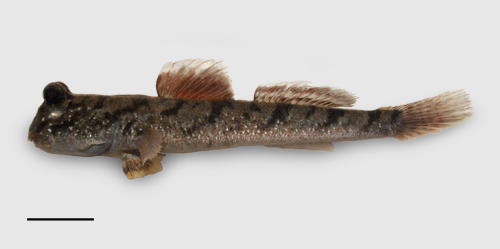
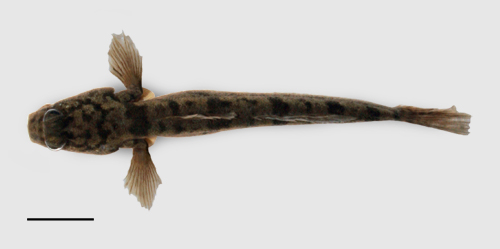
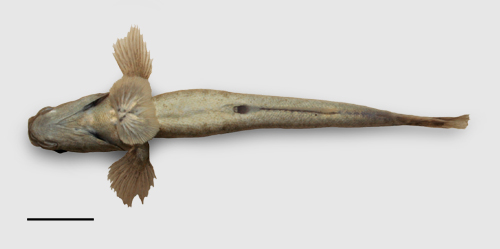
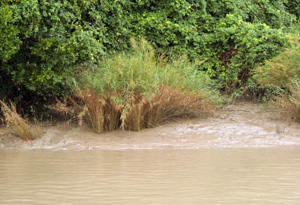
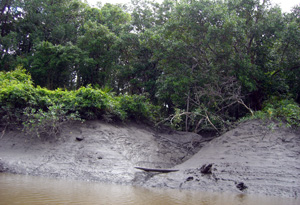
![]()